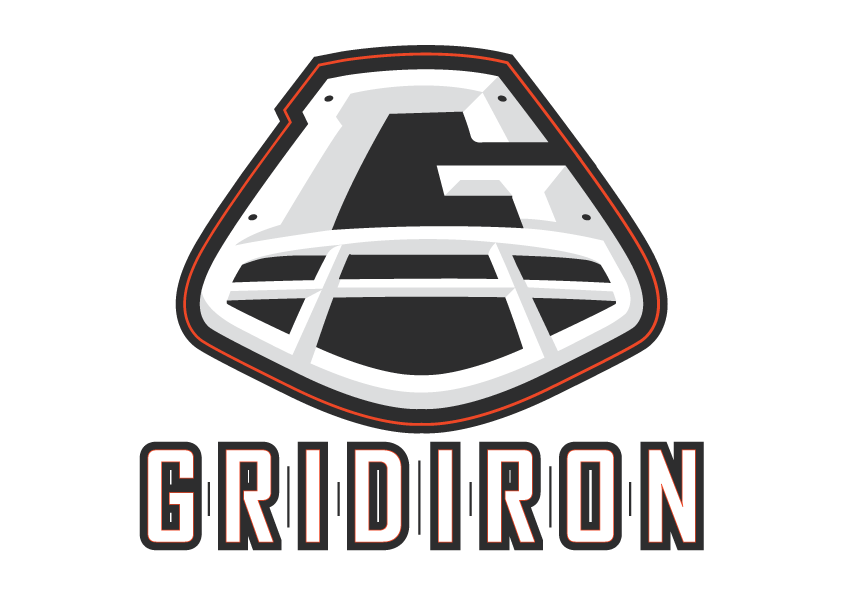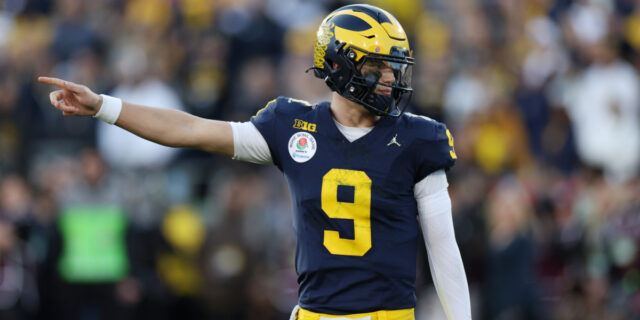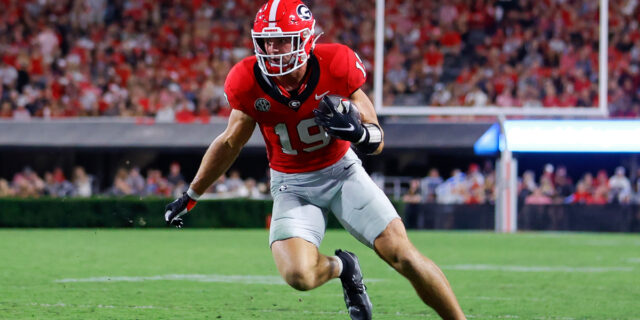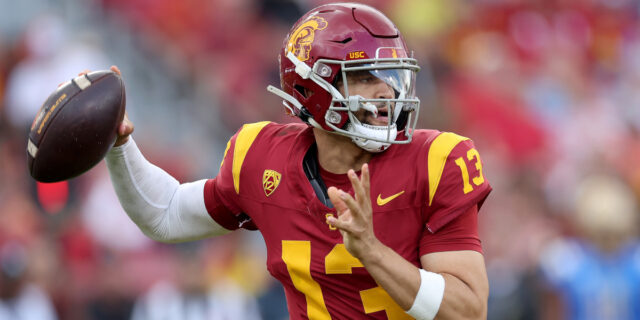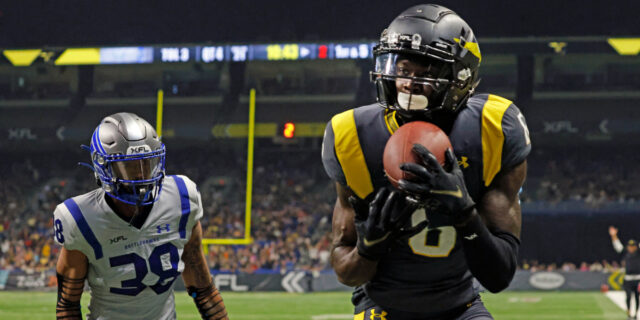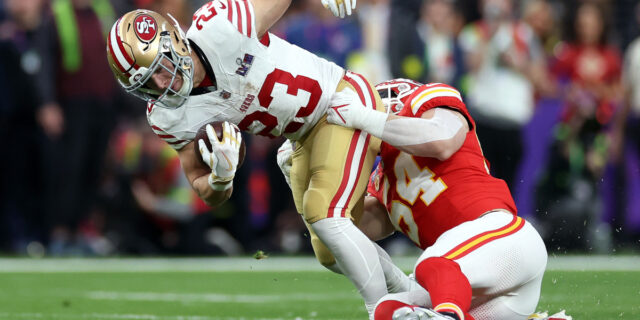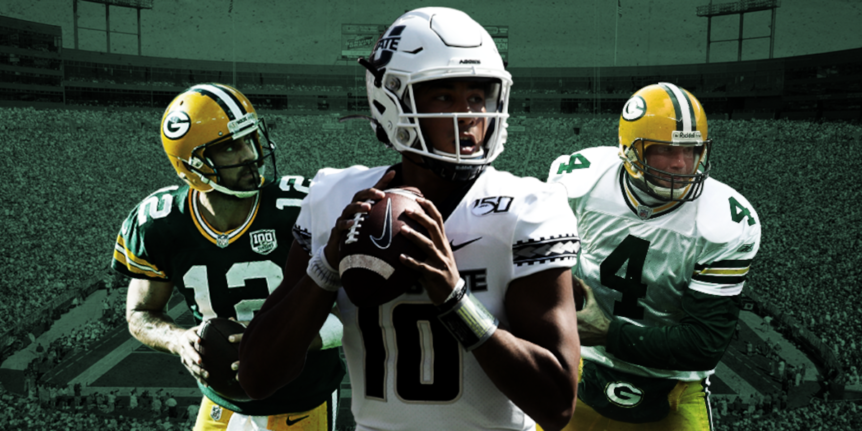
History Repeating?
This article originally appeared in Issue 4 of Gridiron Weekly, back in 2020 – for individual editions or subscriptions, click HERE
Since Brett Favre made his first NFL start on September 27, 1992, the Green Bay Packers have had just six starting quarterbacks. In that same time period, the Cleveland Browns – who didn’t exist between 1996 and 1998 – have had 36. The Favre-Aaron Rodgers eras have spanned 20 postseason appearances and two Lombardi Trophies. By contrast, Cleveland have made the playoffs just twice in that timeframe.
Continuity and production at the game’s most important position has undoubtedly been a huge factor behind Green Bay’s sustained success. And now general manager Brian Gutekunst has lined up the next leg of the Packers relay by drafting Utah State quarterback Jordan Love in the first round. Love will wait, arm outstretched, to take the baton from Rodgers at some point in the coming seasons. History suggests that handover will not be seamless and you would do well to find an expert who predicts Love can match the Hall-of-Fame feats of Favre and Rodgers. But the hope that he can is what drove Gutekunst to trade up when all logic was telling him to give his current incumbent under centre another weapon.
The Miami Dolphins have won one playoff game since Dan Marino retired in 2000 and the Denver Broncos haven’t made the postseason since Peyton Manning headed off into the sunset. The Packers, more than anyone in the NFL, understand why a good succession plan is paramount. It’s been the driver for two decades of success.
“I tried to drink up Atlanta. I wouldn’t be answering these questions had I stayed.”
As calendars flicked through the early 1990s, memories of the greatness started by Curly Lambeau and continued over Vince Lombardi’s glorious run were fading in the halls of Lambeau Field. The Packers remained the most successful club in NFL history having won a record 10 championships, but the last – earned nearly a quarter of a century earlier – felt an increasingly distant memory. The old magic had seemingly departed with the legendary Lombardi, with Green Bay featuring in just three playoff games following his departure up until 1992.
That year, however, would bring meaningful change via the arrival of new general manager Ron Wolf. His belief was that the Packers required an on-field maestro who could become as iconic as Bart Starr was during Lombardi’s halcyon era. And his method of securing that person was to make a move almost as leftfield as Gutekunst’s decision to trade up for Love. Wolf parted with a first-rounder for Atlanta’s third-string quarterback Favre, a man described to Gridiron by Falcons head coach Jerry Glanville as “a colt who couldn’t be tamed”; one who failed to even turn up for the team picture. “I tried to drink up Atlanta,” Favre tells Gridiron. “I wouldn’t be answering these questions had I stayed.”
But Wolf had done his research on the quarterbacks entering the 1991 draft during a spell at the New York Jets and was smitten with a Southern Mississippi signal caller who had a endured a spotty senior season, which Favre played just a month after having 30 inches of intestine removed following a car accident. Wolf considered Favre “the best player in the draft” after his performance in the East-West Shrine Game and that affection only grew after witnessing him first-hand as a rookie passer during a scrimmage with the Seattle Seahawks. “Favre was the star,” Wolf recalls. “He substantiated everything I believed.”
That strength of belief is what convinced Wolf to trade a first-round pick 75 days into his tenure for the man he believed could restore glory to Green Bay. Experts hated a Packers GM making such an aggressive move (stop me if you’ve heard that one recently) and fans wrote to president Bob Harlan asking what the heck was going. But Wolf would be vindicated. “I staked my career on him, and he didn’t let me down,” adds Wolf. “Anytime a franchise gets a player like Brett, it’s rare. He changed that organisation from a loser to a winner.”
It helped, of course, that Favre landed in the one place where football was all he had. There was nowhere “to drink up”, as the man himself later admitted: “Green Bay is a small town who love their football. I needed both. It saved my career.”
Not that Favre was an instant success in Titletown. In the 1992 preseason, he had a passer rating of 46.0 having tossed six interceptions compared to one touchdown. Then, his first regular-season pass attempt was a completion, to himself, for a seven-yard loss, with Favre having caught a ball batted back to him. In his first extended action in Week 3, he fumbled four times, failed to decipher multiple blitzes and struggled with formations. The Packers were heading for defeat until Favre, as he would so often do in the coming years, produced two moments of magic. Starting from his own eight with 1:07 left and Green Bay down 23-17, he fired off huge completions to Sterling Sharpe and Kitrick Taylor, the latter pass a game-winning touchdown that thrilled Lambeau Field and started a legend.
Favre would make the Pro Bowl that season – his first of nine selections as a Packer – and the following year he had led Green Bay back to the postseason after an 11-year absence. Neither Favre nor the Pack ever looked back. With the great Reggie White on board, they emerged victorious at Super Bowl XXXI shortly after Favre won the second of his three straight MVP awards.
By 2004, Favre was hardly slowing down. As a quarterback who turned 35 during the season, he had passed for over 4,000 yards and ranked in the NFL’s top five for yardage, touchdowns and completions. At that point, he had only mused on the possibility of retirement. But that didn’t stop another new general manager keen to make his own mark on the team from making the bold decision to select his quarterback’s heir apparent rather than get him some help on April 23, 2005.
“It came down to personality because we thought Alex [Smith] had the better chance of being more consistent. Aaron was moody, and rubbed some players and coaches up the wrong way – which made us nervous.”
Ted Thompson’s inaugural draft pick was an undoubted slam dunk, though he anticipated “catching some heat” when choosing Rodgers. It seems unfathomable now but that night in the Jacob K. Javits Convention Center, Rodgers, a presumptive first overall pick in some mocks, remained in the green room waiting for his name to be called as the opening round unravelled with everyone passing on the quarterback from Cal. The San Francisco 49ers, of course, chose Alex Smith with the first selection.
“On pure talent, Aaron was the guy,” then Niners’ VP of personnel Scot McCloughan told Gridiron recently. “But it came down to personality because we thought Alex had the better chance of being more consistent. Aaron was moody, and rubbed some players and coaches up the wrong way – which made us nervous.”
At pick 24, Thompson recognised talent far outweighed need. The Packers front office knew they had the most durable quarterback in NFL history – a man who would retire having started a record 297 successive games – but they also needed to think about what was next. Fail to find Favre’s successor and they might have another quarter-century in the wilderness.
The coaches in the Packers’ war room could not believe it. It might be four years before Rodgers would see the field. Here they had a Hall of Fame quarterback in his prime and a Super Bowl window that they needed to keep open. And yet, as with Wolf, Thompson was vindicated.
Rodgers would sit behind Favre for three uneasy years – the veteran not wanting to accept his role of mentor willingly – and it allowed Green Bay to transition from one great to another by the time the quarterback change was made in 2008. The Packers missed the playoffs in Rodgers’ first season as starter but made the postseason in each of the next eight campaigns. Super Bowl victory number four came in Rodgers’ third year as the main man – and his sixth in the NFL. “In Green Bay, Aaron got to see the game and it slowed down for him,” McCloughan added. “That’s part of why he’s so special. He got to live the system without being forced to play it.”
By 2019, Rodgers was hardly slowing down. As a quarterback who turned 36 during the season, he had passed for over 4,000 yards, been named to the Pro Bowl and led the league in having the lowest interception percentage among regular starters. But that didn’t stop a (relatively) new general manager keen to make his own mark on the team from making a bold decision to select his quarterback’s heir apparent rather than get him some help on April 23, 2020.
“It doesn’t excuse some of his bad play. It doesn’t excuse some of his bad interceptions. And the marijuana thing was so dumb.”
Jim Nagy knows a thing or two about draft prospects. He spent nearly two decades as an NFL scout and was on staffs for teams that won four Super Bowls. Now, he is the executive director of the Senior Bowl, a man with a close-up view of the talent that enters the NFL each year.
So, when Gridiron asked him about the top quarterbacks in the 2020 class, it was not Joe Burrow, Tua Tagovailoa or Justin Herbert who he really waxed lyrical about.
“Really, I think Jordan Love has the highest ceiling of any of them, if you just look from a pure passing standpoint and the natural tools and how easy he plays the game,” enthuses Nagy. “Four years from now, we could be talking about Jordan Love like he could be the best one in this class.”
If that’s the case, Gutekunst will be vindicated, just as Wolf and Thompson were. All the naysayers, those applying the lowest grades to his third draft, will be made to look foolish. The immediate concern, as it was when Rodgers arrived in Green Bay 15 years ago, is that this is an unnecessary first-round selection, one that offers no obvious immediate help to this team and hinders their next Super Bowl bid as the current signal-caller bristles at knowing he is on borrowed time.
Love looks like the type of prospect who would benefit from an extended period learning under Rodgers’ wing. A scrawny converted wide receiver at high school who had just one scholarship offer to play FBS ‘ball, he took a step back in his senior season, throwing an FBS-high 17 interceptions.
His draft stock took a further hit when he was cited for marijuana possession in December, a case that was dismissed the following month. “The Love kid scares me,” a former NFL general manager told Gridiron before the draft. “He had a very poor season compared to 2018. I get that he had a lot of changes on that team, both with on-field personnel and with his coaching staff so you have to take that into consideration a little bit. But it doesn’t excuse some of his bad play. It doesn’t excuse some of his bad interceptions.
“And the marijuana thing was so dumb. Why are you involved? This is a kid who’s talked all his life about making it to the NFL and then he does that five months before he gets drafted? That’s an all-time dumb move. I just don’t get why he put himself in a situation like that. And I get that a lot of these kids smoke weed. But even so. Why endanger your future like that? On the field he has some serious arm talent. He needs proper coaching, but he does have the tools.”
The era of sitting behind starters, of learning your craft before making it onto the NFL gridiron as Rodgers did, has largely gone. The need for immediate success is too great. Patrick Mahomes’ apprenticeship spanned 15 games because the Kansas City Chiefs had a fine starter, the aforementioned Smith, already at the helm. Baker Mayfield’s lasted two-and-a-bit weeks because the Cleveland Browns did not.
Love may never reach the heights of Favre or Rodgers, but he has arrived in a perfect and now unique environment to realise his potential in the years to come. The Packers appreciate the need to swiftly transition from one franchise quarterback to another while some teams spend decades fruitlessly searching for ‘that guy’. Like it or not, history will tell you there is a method behind the Green Bay’s madness.
This article originally appeared in Issue 4 of Gridiron Weekly, back in 2020 – for individual editions or subscriptions, click HERE
